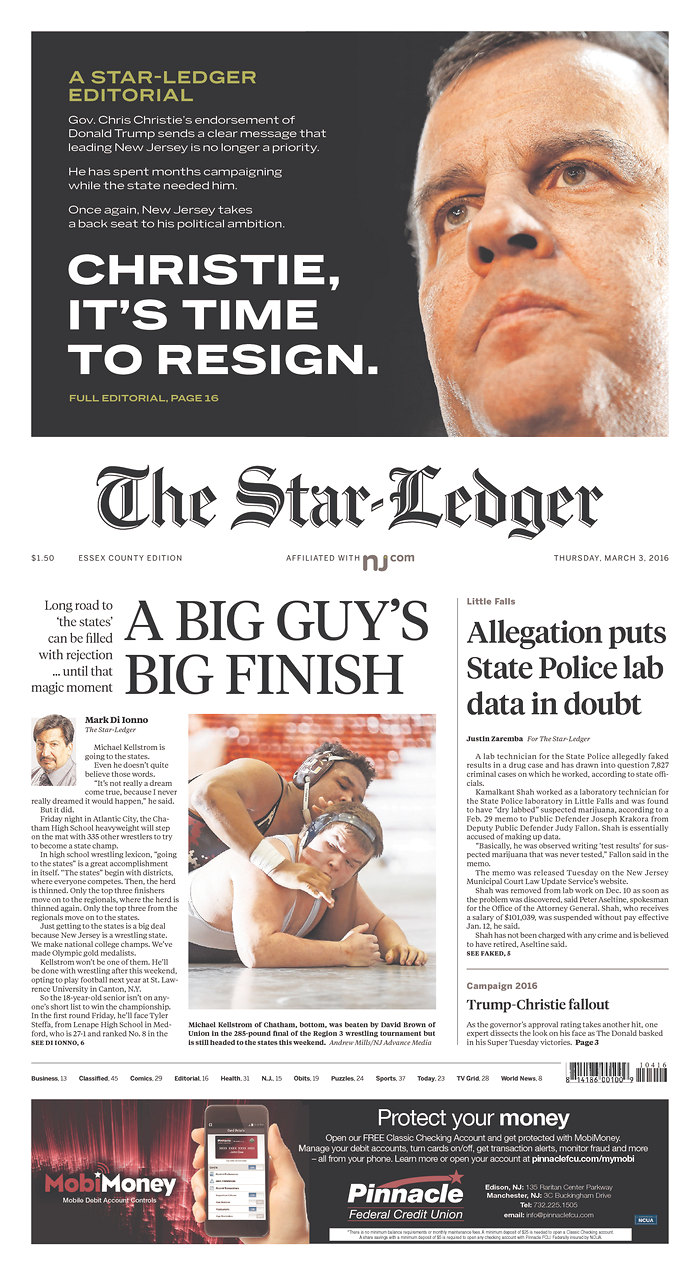New Jersey’s Star-Ledger joined the chorus of newspapers in the state calling for Gov. Chris Christie to resign on Thursday. And with a large, above-the-fold promo, it used the front page to make the case.

“We figured that it’s a very dramatic moment,” said Tom Moran, the Star-Ledger’s editorial page editor, “and we wanted as many people to know about our decision on this as possible.”
The editorial, published in its entirety on an inside page, warns of a Christie governorship that will lead to two more years of “wandering in the wilderness”
His disinterest in this state’s most pressing problems is breathtaking. Political and business leaders say they can’t get his attention. He was gone 72 percent of the days in 2015, and even more often during the start of this year. In any other job, he would have been fired long ago.
Christie gave a press conference today and said he wasn’t surprised by the editorial.
“They’re trying to find some way to be relevant, as their circulation declines, as their readership declines, and the only way to do that is to set themselves on fire,” Christie said.
(You can see some of the press conference and read Moran’s response here.)
Newspapers are increasingly turning to front-page editorials to deliver big messages to communities and politicians. In 2011, former Slate senior editor David Haglund wrote that they were relatively rare in the U.S. but becoming more popular. Last year, publications in Las Vegas, Chicago and Indianapolis used the front page to make high-profile statements.
Tony Messenger, a metro columnist at the St. Louis Post-Dispatch, noticed the increase. Messenger, who was editorial page editor at the paper for three years, has never been involved with a front-page editorial but has discussed them with staffers.
“I think it’s really got to rise to the level of the newspaper making a statement about the community that is devastatingly important,” he said. “And it’s got to be your best work. And it’s got to be compelling.”
Messenger paid attention to all of those that ran last year, and he’s not sure they all met those standards.
“I think it’s a difficult bell to ring, ’cause once you ring it, you sort of set a precedent, and if you ring it on the wrong issue, you sort of put your newspaper in a tough spot,” he said.
Newspapers also have to be careful not to ring that bell too often.
Front-page editorials have impact because they’re unusual,” said Jennifer Hemmingsen, opinion page editor of The (Cedar Rapids Iowa) Gazette and TheGazette.com.
“You want to make sure not to make your audience numb to it.”
Nancy Ancrum, editorial page editor at the Miami Herald, agreed.
“It should be very, very rare,” she said, “otherwise, you’re squandering your voice.”
People also need to understand quickly that what they’re seeing is opinion. Print readers are used to seeing news on the front page and editorials on the editorial page. When those two cross borders, it needs to be very clear. That problem can be handled with good design, Hemmingsen said.
The Miami Herald is currently considering a front-page editorial for the eve of the president’s visit to Cuba. It’s a historic visit that’s sure to enrage some community members and make others proud, Ancrum said.
Tim Swarens, opinion editor at The Indianapolis Star, has held that job since 2003. Last year was the first time the paper ran a front-page editorial.
It's this important. Tuesday's front page. #rfra pic.twitter.com/gVPf82J2iu
— Mark Alesia (@markalesia) March 31, 2015
The editorial pushed back against the Religious Freedom Restoration Act, which would override local human rights ordinances protecting the LGBT community. The act also had the potential to make a big impact on city and state business. When Indiana’s governor indicated that he was open to solutions, the newspaper stepped up. The paper’s publisher suggested they be bold in putting forth a fix. The publisher and members of the editorial board decided to put the editorial on the front page.
The Star is digitally-focused, Swarens said, so the Tuesday print edition isn’t something they normally put a lot of energy into.
“The idea of making a dramatic stand on a Tuesday front page was counterintuitive to our digital focus,” he said.
So he was surprised when that front page went on to shape the conversation over the next few days, he said, particularly on social media.
Younger readers who don’t pick up the print edition still understand the significance of the front page, he said, and they get that when the entire front is devoted to something, it must be important.
Swarens’ criteria for making it onto the front page: It has to be a big story. It has to be of broad interest. It should build on the paper’s connection with the community. And the paper should be prepared to hit an issue hard.
“And it needs to be something where the editorial board of the newspaper can make a real difference,” he said. “It shouldn’t be just a gesture.”







